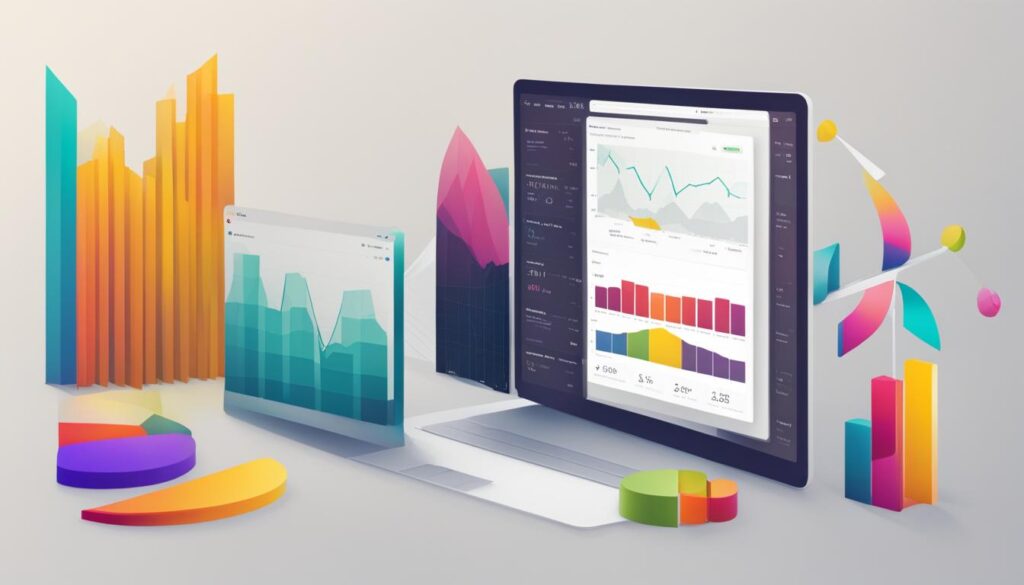Over the years, data visualization has evolved from simple drawings on cave walls to the comprehensive digital dashboards of today. As MIT research suggests, the human brain processes up to 90% of its information visually, making the use of beginner-friendly data visualization tools, easy-to-use graphing software, and intuitive data visualization software vital in shaping the modern data landscape. Novices intimidated by extensive coding can take solace in a selection of free tools that streamline complex data visualization processes while requiring minimal technical skills. By leveraging the power of these tools, beginners can easily craft captivating visual stories through graphics, charts, and maps.
Key Takeaways
- Visual information processing is crucial for the human brain, as reinforced by MIT research.
- Beginner-friendly data visualization tools help users create compelling visual stories without extensive technical know-how.
- Data visualization newcomers can take advantage of several free and accessible tools to streamline their processes.
- These tools can greatly simplify the process of creating graphics, charts, and maps, making them more accessible to novices.
- Accessible data visualization platforms can foster better understanding and engagement by transforming complex data into easy-to-digest visual narratives.
The Evolution and Importance of Data Visualization
Data visualization’s history is rich and diverse, stretching back to the earliest days of human communication and now residing at the core of modern data analytics. The transition to digital dashboards reflects the human inclination towards visual material. These contemporary tools embody the surge in data visualization usage, driven by technology’s integration into every field and demand for digestible visual representations of complex data.

From Ancient Graphs to Digital Dashboards
The origins of data visualization date back to cave paintings and early geographical maps. Over time, the practice has evolved to accommodate the growing complexity of information and the need for user-friendly data visualization platforms. The advent of the digital era has facilitated the creation of dynamic, interactive visualization tools capable of handling large volumes of data. Today, digital dashboards have become the gold standard for presenting and interpreting data across industries.
A Picture’s Worth: The Power of Visual Analytics
A picture is worth a thousand words
In the realm of data visualization, this adage stands true, as visual analytics empower stakeholders across various disciplines to interpret large datasets expediently and to extract actionable insights. Visualizations enable swift and informed decisions, allowing businesses to better respond to market trends, optimize operations, and monitor performance.
Data visualization serves as both a method of presentation and as a narrative tool that enhances understanding and engagement. The power of data visualization lies in its ability to transform massive quantities of complex data into straightforward visual representations. This approach fosters more effective decision-making, driving success for organizations and professionals alike.
| Time Period | Milestone in Data Visualization History |
|---|---|
| Prehistoric | Cave paintings and early maps serve as primitive forms of data visualization. |
| 17th-18th Centuries | Development of early statistical graphs, such as bar charts and pie charts. |
| 20th Century | Emergence of computer-generated visualizations and early digital dashboards. |
| 21st Century | Expansion of simple data visualization tools and widespread integration across diverse fields. |
As the evolution of data visualization continues, the demand for accessible and easy-to-understand tools only grows stronger. Today’s simple data visualization tools have made visual analytics an indispensable resource for professionals and businesses alike, ensuring that information can be easily communicated, understood, and acted upon.
Tableau Public: The Visual Analyst’s Playground
One of the most prominent and accessible graphing tools in the realm of data visualization is Tableau Public. It provides an array of functionalities, such as diverse chart types and maps, and allows users to publish and share their interactive data visualizations widely. Catered specifically for those new to data visualization, Tableau Public is both versatile and user-friendly, serving as an ideal starting point for newcomers.
Tableau Public stands out for its #Datafam user community, which offers a wealth of knowledge, resources, and support for beginners.
While there is an apparent downside to using Tableau Public—the inability to keep data analyses private—its extensive range of features and an engaged community provide a strong foundation for learning and growth in data visualization. In fact, its vibrant community called the #Datafam enables users to learn from one another, share resources, and get the most out of Tableau Public’s capabilities.
Tableau Public’s charting options include:
- Line charts
- Area charts
- Bar charts
- Pie charts
- Maps
- Interactive dashboards
These pooling options open a world of possibilities for creating insightful visual stories with data. Some examples of real-world applications using Tableau Public for data visualization include:
- Tracking the progression of COVID-19 cases over time
- Visualizing government spending across various sectors
- Mapping crime rates and patterns in urban areas
- Comparing sales performance across multiple product lines
- Monitoring social media trends and user engagement
Overall, Tableau Public’s extensive functionality and supportive user community create a thriving environment for anyone interested in exploring the power of data visualization. The platform’s interactive features and diverse chart options make it easy to dive into the world of data representation and analysis without feeling overwhelmed, ensuring a positive learning experience for all who embark on this journey.
Flourish: Digital Storytelling with Data
In an era of content saturation, telling compelling stories becomes a critical skill for information dissemination and communication. Flourish emerges as a premier platform that seamlessly integrates digital storytelling with data, equipping users with the flexibility to construct data-driven narratives without the need for desktop software. This browser-based tool facilitates the creation of interactive and immersive visual content on social media and websites, transforming raw data into visual stories that resonate with audiences.

Bringing Data Narratives to Life
Flourish offers a user-friendly interface that enables individuals, particularly journalists and content creators, to emphasize storytelling through data. The platform’s intuitive design empowers users to craft interactive visualizations from an extensive range of templates, including bar charts, line graphs, maps, and scatter plots, to name a few. With a selection of visually stimulating chart types, Flourish enhances narratives with compelling and informative visual aids for audience engagement.
“Flourish provides journalists and content creators with an efficient means to present data to their audience in an engaging and immersive manner.”
While the free version of Flourish does have limitations, including the lack of Google Sheets integration for data, its ease of use positions it as an excellent resource for users embarking on data storytelling journeys. Users who opt for the premium version unlock additional features, such as private projects, custom branding, and a broader template library.
- Wide variety of templates for interactive data visualization
- Intuitive interface for seamless content creation
- Enables data-driven storytelling for journalists and content creators
- Offers premium features for advanced users
| Features | Free Version | Premium Version |
|---|---|---|
| Templates | Limited | Extensive |
| Integration | No Google Sheets | Google Sheets supported |
| Privacy | Public projects | Private projects |
| Branding | Flourish logo | Custom branding |
Overall, Flourish stands as an invaluable tool for infusing data narratives with life, offering content creators a platform that caters specifically to digital storytelling and interactive visualization. Whether users are beginners or seasoned professionals, Flourish delivers a versatile means of communicating complex data in an appealing and easily digestible format.
Infogram: Where Simplicity Meets Functionality
Infogram, an impressive addition to the array of user-friendly data visualization apps, is highly appreciated for its simplicity and functionality. This beginner-friendly charting software simplifies the process of creating various types of interactive visualizations by providing a diverse range of templates and supporting direct data imports from multiple online sources.
Suited for marketers and business leaders seeking straightforward solutions, Infogram offers the convenience of crafting content like email headers and social media posts with minimal effort. The platform comes with an assortment of built-in templates and designs that make it a breeze to create visually appealing and professional-looking reports and dashboards.
“Infogram has made our analytics reports much more dynamic and engaging, which makes a world of difference in a data-heavy field.”
Although the free version of Infogram includes prominent branding on inserted charts on websites, the software’s simplicity and user-friendly interface make it a top choice for individuals seeking a hassle-free experience in data visualization.
Infogram’s main features include:
- Wide selection of templates for charts, maps, and infographics
- Drag-and-drop interface for ease of use
- Integration with online data sources, such as Google Sheets and Microsoft Excel
- Customizable design and styling elements
- Responsive designs optimized for various screen sizes
In summary, Infogram combines simplicity and functionality to provide a beginner-friendly data visualization app that caters to the needs of marketers and business leaders seeking an uncomplicated and efficient solution. By offering an extensive range of templates and supporting direct data imports, Infogram eliminates the barriers often encountered by newcomers to the field of data visualization, empowering them to create informative and visually appealing content with ease.
Conclusion
The wide array of beginner-friendly data visualization tools available today serves as a testament to the growing demand for easy-to-understand data visualization platforms. From Tableau Public’s comprehensive graphic options to Flourish’s storytelling prowess and Infogram’s simplicity in design, these straightforward visualization tools cater to various users’ needs without sacrificing essential functionalities.
These platforms have successfully made data visualization less intimidating for beginners, providing resources that empower users to create visually appealing and informative content. By transforming complex data into clear, insightful visual narratives, newcomers to data visualization can rapidly develop their skills and deliver impactful visualizations without requiring advanced technical expertise.
In conclusion, the increasing accessibility of user-friendly data visualization apps underlines their significant role in modern data analytics. As beginner-friendly platforms continue to evolve, the scope and potential of visually representing complex data will only grow, resulting in better-informed decisions and a more visually literate audience.
FAQ
What are some beginner-friendly data visualization tools?
Some beginner-friendly data visualization tools include Tableau Public, Flourish, and Infogram. These platforms offer easy-to-use graphing software, intuitive data visualization software, and interactive visualizations designed for users new to data visualization.
How has data visualization evolved over time?
Data visualization has a rich history, progressing from primitive forms like cave paintings to sophisticated digital dashboards in modern data analytics. The transition to digital dashboards signifies the human inclination towards visual material and technology’s growing integration into diverse fields.
Why is data visualization important?
Data visualization is vital because it enables users to interpret large datasets quickly and extract actionable insights from them. Visual analytics facilitate swift, informed decisions, and serve as a narrative tool that enhances understanding and engagement.
What makes Tableau Public suitable for beginners?
Tableau Public offers accessible graphing tools, diverse chart types, and maps, enabling users to create interactive data visualizations without prior technical knowledge. Its strong user community, known as #Datafam, supports newcomers and makes Tableau Public an ideal learning platform.
How does Flourish enable digital storytelling with data?
Flourish is a browser-based tool tailored for digital storytelling. It allows users to animate data-driven narratives without the need for desktop software, creating interactive and immersive content on social media and websites. Flourish is particularly useful for journalists and content creators who emphasize storytelling through data.
What features does Infogram offer?
Infogram simplifies the creation of various types of interactive visualizations by providing a variety of templates, supporting direct data imports from multiple online sources, and allowing users to generate easy-to-create content like email headers and social media posts. Although Infogram has some limitations in its free version, it remains a user-friendly platform for creating visually appealing reports and dashboards quickly.
